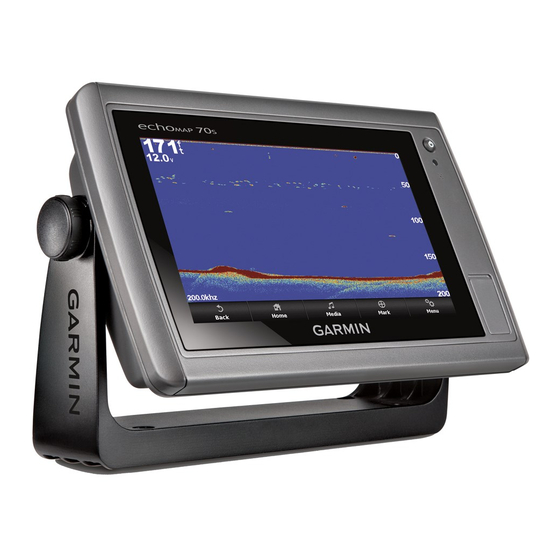Defining a Partial Guard Zone
You can define the boundaries of a guard zone that does not
completely encompass your boat.
1
From the sentry screen, select Menu > Sentry Setup >
Adjust Guard Zone > Move Radar Guard Zone > Corner 1.
2
Touch and drag the location of the outer guard-zone corner
.
3
Select Corner 2.
4
Touch the location of the inner guard-zone corner
the width of the guard zone.
Viewing a List of AIS Threats
From any Radar screen or the Radar overlay, you can view and
customize the appearance of a list of AIS threats.
From a Radar screen or the Radar overlay, select Menu >
Other Vessels > AIS List.
Showing AIS Vessels on the Radar Screen
AIS requires the use of an external AIS device and active
transponder signals from other vessels.
You can configure how other vessels appear on the Radar
screen. If any setting (except the AIS display range) is
configured for one radar mode, the setting is applied to every
other radar mode. The details and projected heading settings
configured for one radar mode are applied to every other radar
mode and to the Radar overlay.
1
From a Radar screen or the Radar overlay, select Menu >
Other Vessels > Display Setup.
2
Select an option:
• To indicate the distance from your location within which
AIS vessels appear, select AIS Display Range, and
select a distance.
• To show details about AIS-activated vessels, select
Details > Show.
• To set the projected heading time for AIS-activated
vessels, select Projected Heading, and enter the time.
• To show the tracks of AIS vessels, select Trails, and
select the length of the track that appears.
VRM and EBL
The variable range marker (VRM) and the electronic bearing line
(EBL) measure the distance and bearing from your boat to a
target object. On the Radar screen, the VRM appears as a circle
that is centered on the present location of your boat, and the
EBL appears as a line that begins at the present location of your
boat and intersects the VRM. The point of intersection is the
target of the VRM and the EBL.
Showing the VRM and the EBL
The VRM and the EBL configured for one mode are applied to
other radar modes.
NOTE: The VRM and the EBL cannot be changed in sentry
mode.
From a radar screen, select Menu > Show VRM/EBL.
Radar
Adjusting the VRM and the EBL
Before you can adjust the VRM and the EBL, you must show
them on the Radar screen
page
23).
You can adjust the diameter of the VRM and the angle of the
EBL, which moves the intersection point of the VRM and the
EBL. The VRM and the EBL configured for one mode are
applied to all other radar modes.
1
From a Radar screen, select a new location for the
intersection point of the VRM and the EBL.
2
Select Drop VRM/EBL.
3
Select Stop Panning.
Measuring the Range and Bearing to a Target Object
Before you can adjust the VRM and the EBL, you must show
them on the Radar screen
page
23).
1
From a Radar screen, select the target location.
2
Select Measure Distance.
The range and the bearing to the target location appear in the
upper-left corner of the screen.
to define
Radar Overlay
When you connect your chartplotter to an optional Garmin
marine radar, you can use the Radar overlay to overlay radar
information on the Navigation chart or on the Fishing chart.
The Radar overlay superimposes radar information on the
Navigation chart or the Fishing chart. Data appears on the
Radar overlay based on the most recently used radar mode
(such as Harbor, Offshore, or Sentry), and all settings
configurations applied to the Radar overlay are also applied to
the last-used radar mode. For example, if you use Harbor mode
and then you switch to the Radar overlay, the Radar overlay
would show Harbor mode radar data. If you changed the gain
setting using the Radar overlay menu, the gain setting for
Harbor mode would change automatically.
Radar Overlay and Chart Data Alignment
When using the Radar overlay, the chartplotter aligns radar data
with chart data based on the boat heading, which is based by
default on data from a magnetic heading sensor connected
using a NMEA 0183 or NMEA 2000 network. If a heading sensor
is not available, the boat heading is based on GPS tracking
data.
GPS tracking data indicates the direction in which the boat is
moving, not the direction in which the boat is pointing. If the boat
is drifting backward or sideways due to a current or wind, the
Radar overlay may not perfectly align with the chart data. This
situation should be avoided by using boat-heading data from an
electronic compass.
If the boat heading is based on data from a magnetic heading
sensor or an automatic pilot, the heading data could be
compromised due to incorrect setup, mechanical malfunction,
magnetic interference, or other factors. If the heading data is
compromised, the Radar overlay may not align perfectly with the
chart data.
Showing the Radar Overlay
The radar overlay displays data based on the most recently
used radar mode.
Select Charts > Radar Overlay.
The radar picture appears in orange and overlays the
navigation chart.
Setting a Custom Park Position
If you have more than one radar on your boat, you must be
viewing the radar screen for the radar you want to adjust.
(Showing the VRM and the EBL,
(Showing the VRM and the EBL,
23

